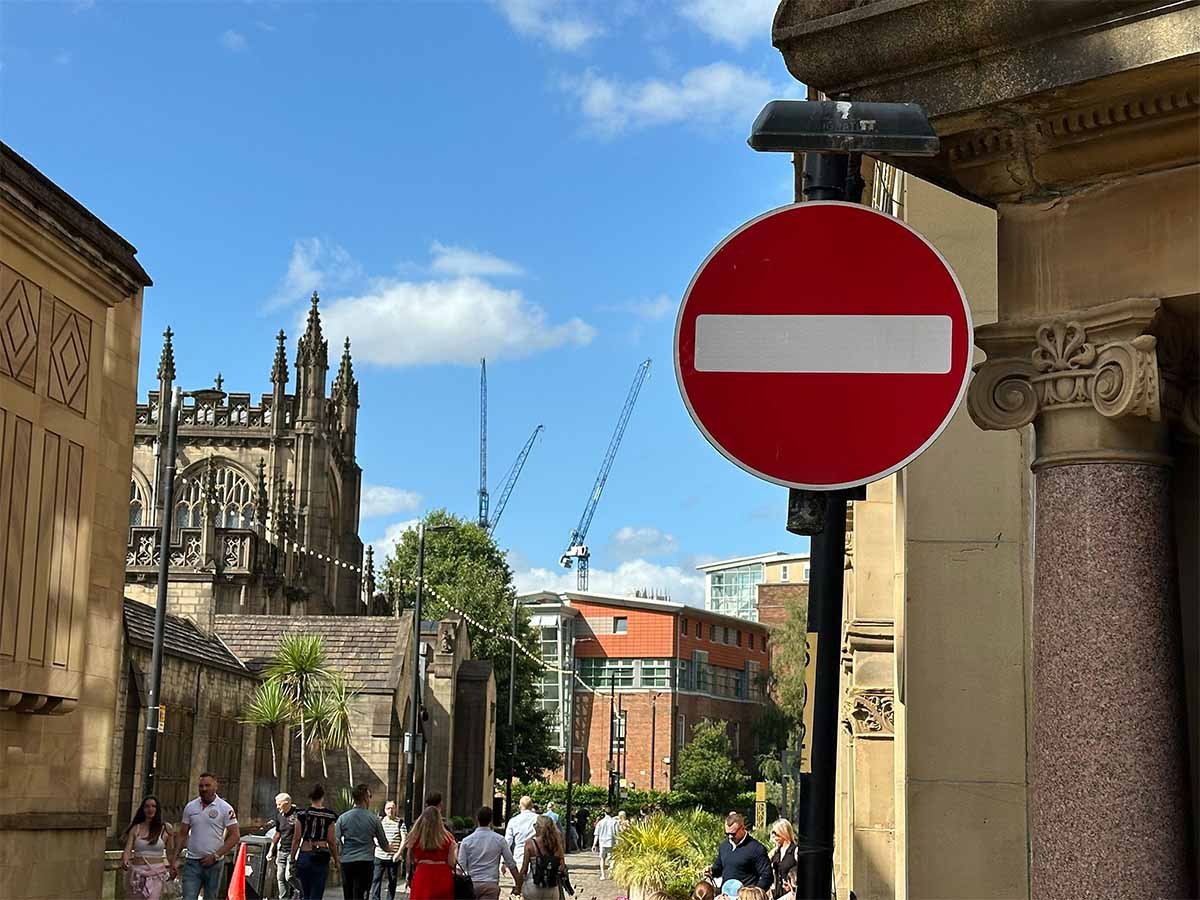A lot of driving on the road is being safe and aware of your surroundings, a great way you can do that is to know your road signs and what they mean. There are so many different signs that mean different things, which is why we have broken this page down by sign type and explained why signs are formatted the way they are.
Road signs are there for a reason, usually to advise you and keep everyone on the road safe, and while there are some obscure ones out there, there are a lot of fundamental signs you need to know that are used frequently on UK roads. This is your one-stop shop for all things UK road signs.
Please use the table of contents to make navigating this page easier. Firstly, we’re going to take a look at how road signs are formatted, so you know how to behave when you see them.
UK road sign shape meaning
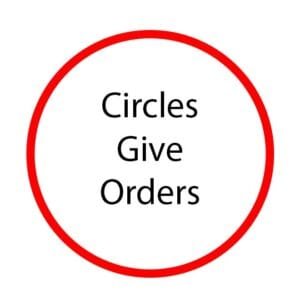
Circle sign shapes give orders to road users, some circle signs include speed limit signs and mandatory directional signs. These signs are usually either red and white, or blue and white.
It is important that you follow the rules depicted by these signs, as circular road signs give orders on UK roads, they should be followed if you wish to stay inside the law.
Red-bordered signs are especially important because they tell you what you must NOT do.
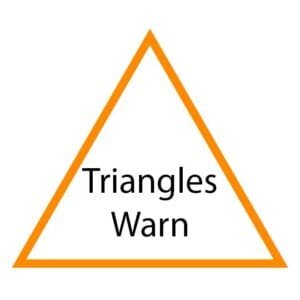
Triangle sign shapes indicate a warning, or something you should be aware of up ahead. Road works, Giveaway, and Roundabout signs are examples of triangle signs.
It is important to heed the warnings that these triangular signs give, as they provide insight into the conditions of the road ahead, or considerations you have to make before approaching potential hazards.
Triangle signs are usually bordered by red, the same as circle signs. This does not mean that these signs are orders, they are merely warnings, but should be listened to nonetheless.

Rectangle signs inform, usually about attractions nearby or to indicate parking. It’s important to note that some rectangle signs do also appear as square.
The rectangle sign is not giving you an order, nor is it warning you of any potential hazards, it is simply letting you know useful information about the area or the rode ahead.
For example, a common rectangle sign is one that warns you of dead ends, or in roads for one way systems.
UK road signs also have a colour attached to them to signify different things, some are used often, and others not very much. You get most of the information you need from the shape of the sign and any text that may be written on it. It’s important to pay attention to all UK road signs, as they inform you of any potential hazards. It’s also important to familiarize yourself with any symbols, as symbols are often used in place of words on UK road signs.
Road signs PDF
If you want a document with examples of important road signs and what they mean, the UK government has made a handy UK road sign PDF that you can download here.
As for our article, let’s start off with arguably the most important signs, the circular signs.
Circle UK road signs
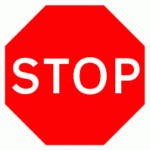
The Stop sign
The stop sign isn’t really a circular sign, it’s octagonal, but it still follows the same rules as a circle sign. When you see a stop sign you MUST obey it. You must come to a complete stop before the stop sign and only continue when your route is clear and it is safe to do so. Stop signs are far less common in the UK than say Give Way signs, but they do still exist.
As mentioned, when you see this sign, you need to come to a complete stop before the Stop sign, and the solid road markings that indicate where you should stop..
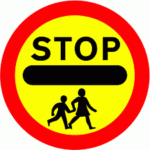
Stop children
This sign is carried by lollipop people, ordering you to stop as they let children cross the road. This is one of the only signs that is carried by a person, and not fixed to a point on the road. When you see this sign, you should stop before crossing the sign and allow children to cross the road.
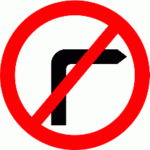
No right turn
This sign prohibits right turns. If you see this on the road immediately before a right turn, assume you are not allowed to turn right. The only exception is if you are allowed via a supplementary sign, perhaps “except coaches” and you are a coach. In that case, you may turn right.
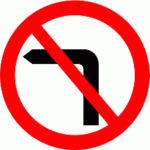
No left turn
This sign prohibits left turns. The same rules apply to all directional signs, you are not allowed to do what’s displayed on the sign, in this case, turn right, unless told otherwise by a supplementary sign.
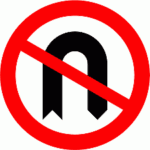
No U-turns
This sign prohibits performing a U-turn on a given road or junction. These signs are usually put in a place where it would be dangerous to make a U-turn, or you would have to cross a light-controlled area without the assistance of lights. They are put there for safety and to ensure the undisrupted flow of traffic.
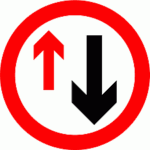
Priority to oncoming traffic
This road sign gives priority to the traffic travelling in the opposite direction, it is usually posted near a narrow road or bridge. You should stop and wait for any oncoming traffic to pass the narrow point before continuing. This sign is usually accompanied by “give way” markers on the road, indicating where to wait.
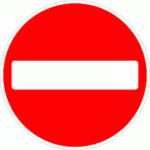
No entry
This road sign prohibits entry to the street by vehicle or bicycle. It usually indicates the end of a one way road, on which the traffic is traveling the opposite direction. You should not attempt to enter any road marked with a no entry sign.

All motor vehicles prohibited – Except motorcycles
This road sign prohibits the entry of all motor vehicles, whether a car, truck, or wagon. However, solo motorcycles, bicycles and horse-drawn carts are not prohibited and may pass this sign without consequence.
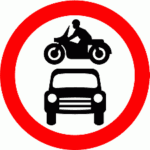
All motor vehicles prohibited – including motorcycles
This road sign prohibits the entry of all motor vehicles including motorcycles. You may not enter past this sign if you are on a motorcycle or in any kind of car. You may still pass this sign if you are a bicycle or horse-drawn carriage, because these do not pose enough threat to pedestrians.
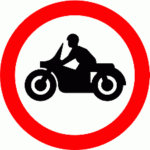
Motorcycles prohibited
This Road sign prohibits access to all motorcycles. This sign would usually be used where a pedestrian or bicycle path would be easily accessed from the road by a motorcycle or scooter.
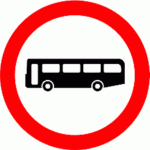
Buses prohibited
This road sign prohibits the entry of buses pas the sign. It may be used on narrow roads, or in areas where busses would cause too much congestion. You may pass this sign in any other kind of vehicle.
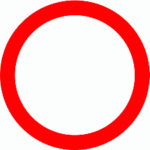
No Vehicles
This is a road sign that prohibits access to all mechanical vehicles of any kind, that’s motorcycles, cars, bicycles, and horse-drawn carts. You are not allowed to move past this sign in any vehicle. These signs are usually used in pedestrian-only areas.
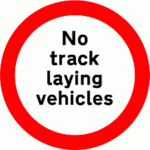
No track-laying vehicles
This road sign prohibits the entry of track-laying vehicles. This is any vehicle that uses a system of wheels and tracks for traction. Examples of these would be diggers and tanks. This usually marks a road that would be unsuitable for track-laying vehicles.

No articulated vehicles
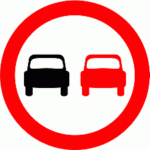
No overtaking
This road sign prohibits drivers from overtaking other vehicles. The sign indicates that the road is too narrow or visibility is too poor to attempt a safe overtake. You should wait until the road widens or visibility increases to overtake.
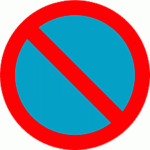
No waiting
The No waiting Road sign is usually a part of another sign and is only rarely displayed on its own. The sign instructs drivers that they are not allowed to stop and wait in the no-waiting area. However, you are allowed to stop to unload or load, but any longer is prohibited.
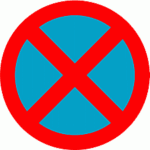
No stopping
The no-stopping sign is often displayed on its own and it instructs drivers that stopping is prohibited unless in an emergency, or instructed by the police. You cannot stop to load or unload in a no-stopping zone, unlike the no-waiting zone.
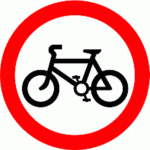
No cycling
This road sign prohibits the use of bicycles or tricycles beyond the sign. This could be used to keep bicycles out of pedestrian-only zones or to keep bicycles off dual carriage ways, which use the national speed limit.
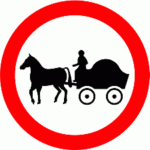
No horse-drawn vehicles
This road sign is used to prohibit horse-drawn vehicles, this includes any vehicle pulled by a horse. It is usually used to protect a route that was only intended for use by cyclists or pedestrians.
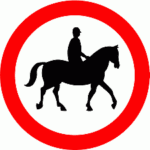
No horses
This road sign prohibits access to accompanied or ridden horses to a given roadway. You are likely to see this sign in a place where people sometimes ride horses on a route that’s intended for cyclists or pedestrians.
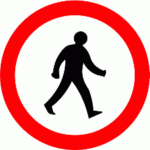
No pedestrians
This is a road sign used to prohibit pedestrians’ access to a roadway or path. You will likely see this sign where a motorway starts close to a normal pedestrian-accessible road. It is used where the use of the road by pedestrians would be unsafe.
UK speed road signs
Speed signs in the UK are also circular, so that means they are giving an order. However, they only display speed information and are rarely accompanied by supplemental signs. There are a mix of both red and blue signs in this category, red usually prohibits (negative) and blue usually supports (positive) actions. There’s also a couple of different speed signs to be aware of, so we have broken them down below.

Maximum speed limit
This road sign displays the maximum speed allowed on a given road. It is not the target speed, nor is the sign dictating that is the speed you must travel, it is only informing you of the maximum allowed speed in MPH.
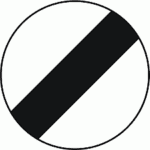
National speed limit
This road sign dictates that the maximum road speed is the same as the national speed limit. The national speed limit is different for vehicle type and road type. Be sure to check which part of the national speed limit applies to you and your vehicle before using roads governed by it.
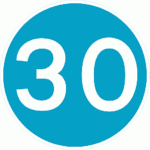
Minimum speed limit
This road sign dictates the minimum speed limit you must travel on any given road if it’s possible in the given conditions. These signs are much rarer than speed limit signs. These signs in the UK always display in MPH.
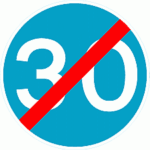
Minimum speed limit ends
This road sign dictates the minimum speed limit zone is ending, and the road should return to being governed by a standard speed limit, or a national speed limit with no minimum speed requirements.
Triangle UK road signs
Triangular road signs are there to serve as a warning, they are not commands or information, but they indicate a hazard on the road ahead. You should pay attention to the warning signs as they display vital information about the road or conditions of the road, warn of animals, crossings, and much more.
Here is a list of some of the UK’s most relevant triangle signs and what they mean.
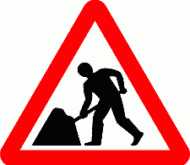
Road works
This road sign is usually used in a temporary form and is used to warn drivers that road works are in progress. This sign is usually accompanied by a supplemental sign that may display words like “start” or “end”, to let you know where the roadworks start or end.
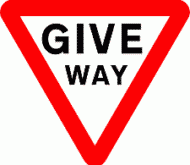
Give Way
The Give Way sign is usually placed at junctions where you do not have the right of way. It is usually accompanied by a white dotted line on the road that indicates the point at which you should give way to other motorists.
The Give Way sign is sort of treated like the American stop sign, although we do have those, it’s not mandatory to stop at a Give Way sign if your path is clear. But you do have to stop if there is a solid white line on the road.
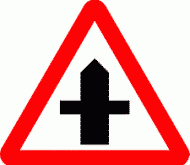
Crossroads ahead
This road sign is part of the junction set of road signs and can come in a few different forms depending on the layout of the road ahead.
This sign in particular warns you of an upcoming crossroads. Or it may be a staggered crossroad, then the sign will display the junctions as staggered. The crossroad could also be accompanied by Give Way lines.
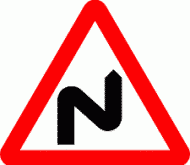
Signs warning of roads ahead
The crossroads sign is not the only one sign that warns of the characteristics of the road ahead, these signs come in many variants and are all pretty easy to read, so we’re not going to show every single one.
If you would like some examples, there are: Left turn ahead, right turn ahead, staggered junction ahead, double bend first to right, and many more.
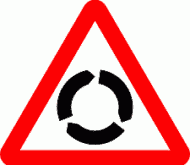
Roundabout ahead
This sign warns you of a roundabout ahead, it can sometimes be accompanied by a supplemental distance sign, but doesn’t have to be.
When you see this sign, you should slow down and expect a roundabout both big and mini, as the sign has no differentiation.
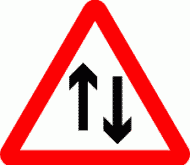
Two-way traffic
This two-way traffic sign warns you of oncoming traffic, it’s usually following a one-way road that has ended. This notifies the driver of a “standard road” beginning.
You should expect oncoming traffic to be on your right when you see this sign, and supplemental signs do not usually accompany it. However, sometimes it can be seen with a one way end sign.
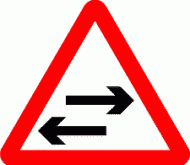
Two-way traffic on route crossing ahead
This two-way traffic sign is similar to the one before it, however it warns of a different thing. This sign tells you that there will be traffic from both directions crossing your route or path.
When you see this sign you should slow down and stop at the point of the crossing, and wait until both sides of the road are clear before proceeding. Look for any give way marks that indicate where to stop and observe.
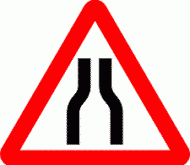
Road narrows ahead
This sign tells us that the road up ahead on both sides will narrow, meaning there will be less room between us and other drivers. It is sometimes used where road works are happening and some areas of the road are coned off.
This sign has two other variants, Road narrows on the left side, and Road narrows on the right side. The sign then depicts a straight line (unaffected road) with a curved inward road (affected side).
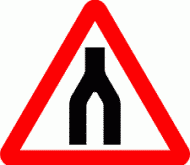
Dual Carriageway ends ahead
This sign signifies that the Dual Carriageway that you are on will soon end, sometimes this sign can be accompanied by a supplemental sign that tells you the distance when the Carriageway will end. But that’s not always the case.
When you see this sign you should prepare for one lane of the Dual Carriageway to merge (usually the right) into another lane. The speed limit may change to accompany the new road type.
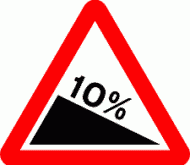
Hill and gradient signs
This road sign will tell you that there is a hill (up or down) ahead, and the text on the sign will tell you how steep the gradient is. A fun fact is the sign percentage is derived from the old ratio system, where 1 in 10 (10%) would mean 1m height change for every 10m travelled.
The higher the percentage on the sign, the steeper the hill, so you have to be ready to downshift, or to upshift, depending if the hill is up or down.
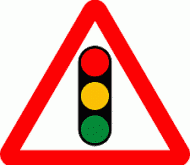
Traffic lights or traffic signals ahead
This road sign dictates that traffic signals are controlling the flow of traffic ahead. These signs are sometimes accompanied by supplemental signs that note the distance of the lights ahead, but this isn’t always true.
These signs are often used to warn road users that there is a temporary traffic light setup around a blind bend. Whenever you see this sign, especially if you’re about to round a tight corner, expect stood-still traffic very soon, and adjust your speed accordingly in a controlled manner.
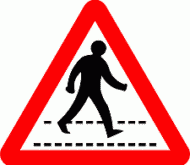
Pedestrians crossing ahead
This sign warns you that there is a pedestrian crossing ahead, it can be any type of crossing. You should expect there to be pedestrans in the road when you pass the sign.
As with the traffic signal sign above, this sign is often used where pedestrian crossings are oscured from traffic, like around a blind corner. So you should keep a keen eye out for the crossing as soon as you see this sign.
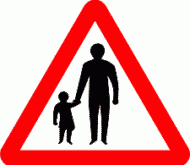
Pedestrians in the road ahead
This is a sign that warns you that there will be pedestrians on the road. This is usually in places that have little to no footpaths on the side of the road.
When you see this sign you should be aware of pedestrians on the side of the road, and move more to ward the centre of the road wherever safe, to give the pedestrians more room.
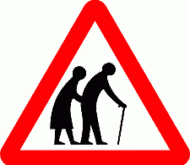
Elderly people ahead
This road sign is designed to warn you that there may be elderly pedestrians on or crossing the road. These signs are usually in place near nursing homes, hospitals, or elderly communities.
When you see this sign you should be aware that there may be slow-moving pedestrians on or around the road, and account for their reduced speed.
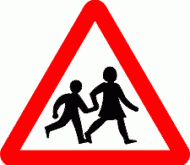
Beware of children
This is a sign that warns you that there are children around, either on the pavement or on the road. The sign is usually posted near or outside of schools, or at popular school route crossings.
When you see this sign you should be wary of children crossing the road, or walking adjacent. Be wary of the speed change if it is an active school zone. Sometimes this sign is accompanied by a speed sign to remind road users to drive slower though school zones.
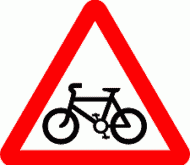
Cycle route ahead
This Cycle route ahead sign tells you that there is an upcoming cycle route. This is sometimes supplemented with the No Bicycles sign, such as when a motorway begins. Cars are not allowed on cycle routes.
When yu see this sign, be wary of the increased presence of cyclists, and watch out for them emerging from the cycle route.
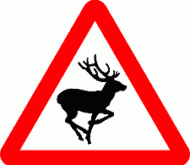
Beware of specific wild animal
This road sign warns you that there is a specific type of wild animal in the area and you may see one crossing the road. Currently there are 7 variations of this sign all depicting different animals, but all mean the same thing.
The current animal signs on UK roads are as follows: Deer (wild animals), Cattle (cows), Sheep, Wild Horses, Accompanied Horses, Toads crossing, and Wild Fowl (Ducks, Pheasant, Etc).
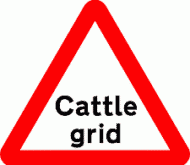
Beware of Cattle gid
This sign warns you that there is a Cattle grid on the road ahead, cars can cross a cattle grid but they should do so slowly, as they tend to be quite narrow and can cause violent vibrations at speed.
When you see this sign, slow down, and allow other cars that may be passing through the Cattle grid plety of time to get through. Cattle grids are usually too small to allow more than one car through at once.
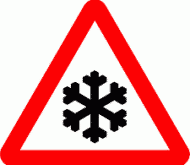
Beware of ice and snow on the road
You’re going to see this one a lot in winter. This sign warns of a road that usually gets icy or covered with snow in winter conditions. It is a sign you should not ignore, as black ice can sometimes be invisible to the human eye traveling at speed.
When you see this sign, take time to assess the conditions of the weather, is it below freezing? Is it early morning and not yet warm enough to melt overnight ice? Taking time to consider these points could save you an accident.
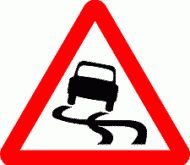
Slippery road
This sign can be used in a multitude of different situations, but it always means the same thing; Slippery road. It could be that the road is naturally wet and slippery, there could be gravel a lot on the road or it could be a result of roadworks.
When you see this sign, take care not to make any sudden sharp turns, or accelerate quickly in a rear-wheel drive car.
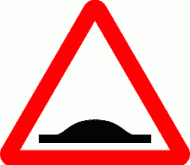
Road humps ahead
This sign is usually used to warn you of speed bumps on the road. This can be in either 20 or 30 MPH zones. The road sign can sometimes be supplemented with additional signs that show speeds.
When you see this, you should take note of the speed and be ready to slow down before you go over a speed bump, it could save your suspension.
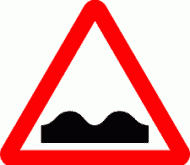
Uneven road surface
Slightly different to the Road humps sign, we have the Uneven road surface sign. This sign usually indicates bumps in the road that are not man made, it’s usually just placed on an area of road that is naturally uneven or bumpy.
When you see this sign, you should anticipate the road being uneven, and account for whether or not your speed over these bumps will cause a loss of control of your vehicle.
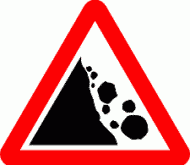
Be aware of falling rocks
This falling rocks sign tells you that your route may be susceptible to falling debris. Roads positioned at the bottom of a cliff face or sheer rocky drop are particularly at risk for this.
When you see this sign, keep a keen eye out for any signs of falling debris. Also, be aware that there may already be debris on the road ahead. Making the road difficult to pass.
This concludes most of the important triangle signs you will find on UK roads. There are plenty more to be seen, but some of them are very obvious and don’t really require any further explanation. For example the Flood sign, this sign simply states the word “flood” in a warning triangle and warns you that the road is liable to flooding. Same situation with the Ford sign.
Remember, warning signs do not require you to obey, they are there to serve as a warning of potential dangers on the road ahead. The only real exception to this rule is the Give Way sign, but whether or not you have to come to a complete stop for that is determined by a solid white line on the road. So, it’s kind of a crossover between road markings and road signs.
We will now move on to square signs, or informational signs, as some prefer.
Rectangle UK road signs
As we have mentioned above, rectangular UK road signs give information to road users, they can sometimes be used as warnings, but you don’t have any obligation to obey them. They are usually just there to tell you the distance towards something or tell you where the parking is. We’ve outlined some of the most common rectangular road signs so you’ll know what they all mean when your time comes on the roads.
Informational road signs usually have plain text written on them, so it’s pretty easy to figure out what they mean. There’s only a few that aren’t marked, so it might be a pretty short list.
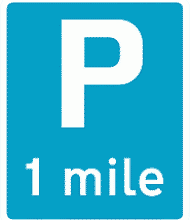
Parking ahead
It might be pretty self-explanatory, but whenever you see a big P sign, it usually means parking. This sign in particular tells you that there is parking on this road in 1 mile. Some parking signs have arrows directing you to the car park and others have distances.
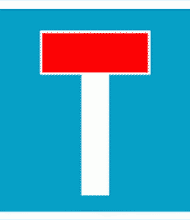
No through road
This sign tells you that the road you are on ends with a dead end, there’s no way to get through to another road. These signs are often posted at the entrances to col-de-sacs and around town centres with a lot of one-way roads.

One way traffic
This sign tells you that this road is set up to be a one-way system. if you’re seeing this sign, it means you are going with the flow of traffic in the correct direction. This sign is sometimes supplemented with a plain text sign that states “one way”.
If you were on the other side of the one-way system, you’d likely be met with a “No Entry” sign. We showed you one of those before.

Priority over traffic in the opposite direction
This sign tell s you that you have the right of way over traffic travelling in the opposite direction. These are usually in use where there is a narrowing of the road due to speed calming measures, or due to residential parking that makes a 2-lane road too narrow.
Watch out for oncoming traffic, but they should be stopping for you since you have the right of way. Be careful though, just because they should, doesn’t mean they will.
This concludes our UK road sign collection. We have gathered all of the important road signs that we feel everyone should learn to be safe on Britain’s roads, especially new drivers. Once learning the meaning of all these signs, you’ll be ready to navigate Britain and be able to fully understand and appreciate the network of road signs that we have ensuring our safety, and governing our streets.
There are, of course, many more UK road signs, we just gathered the essentials.

